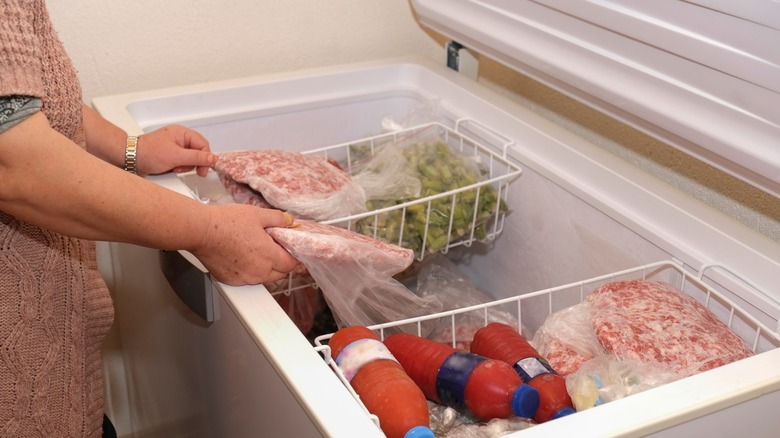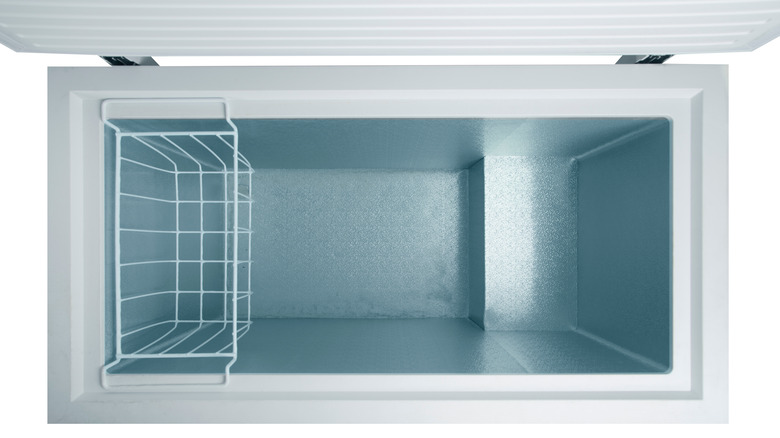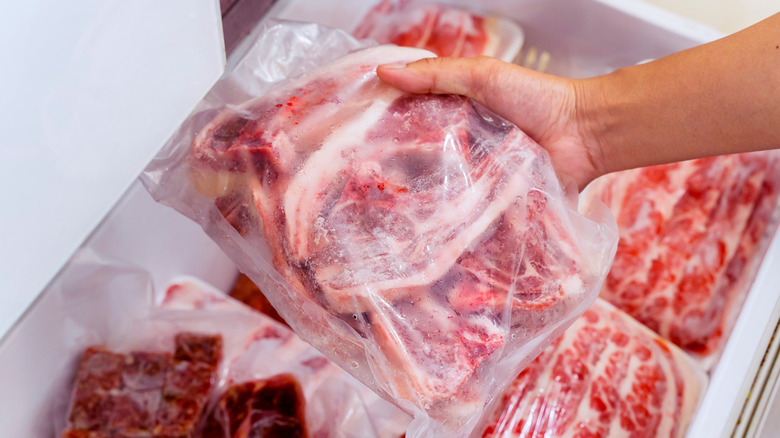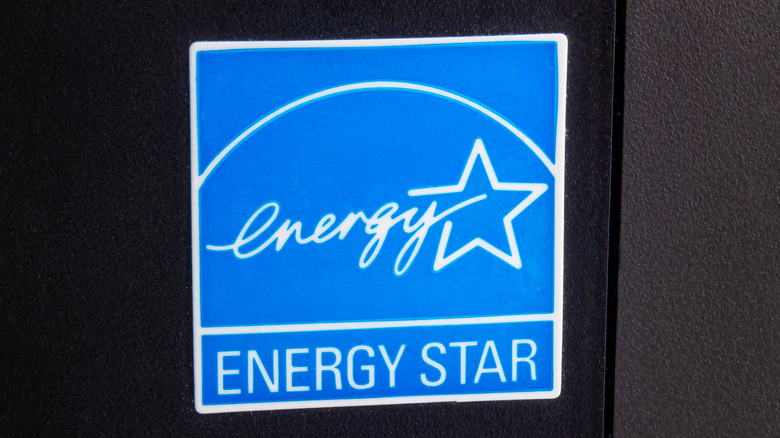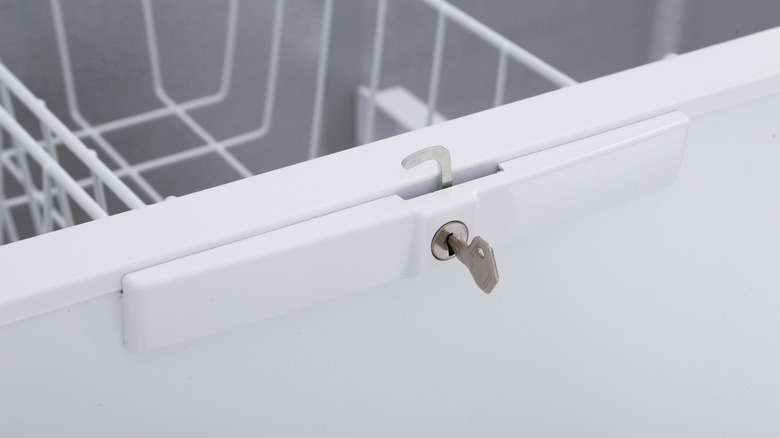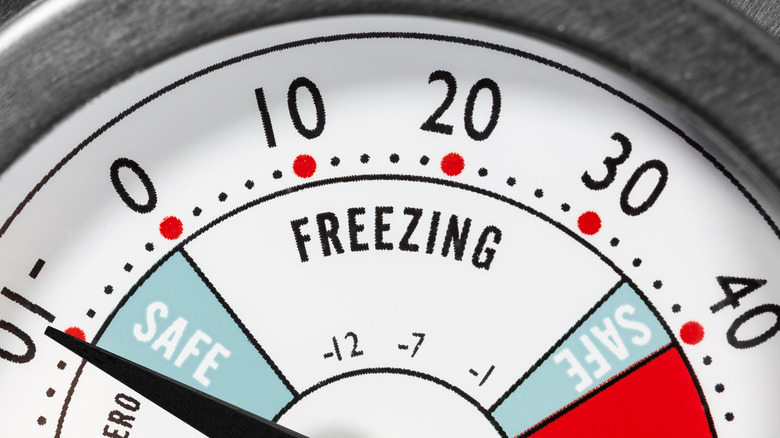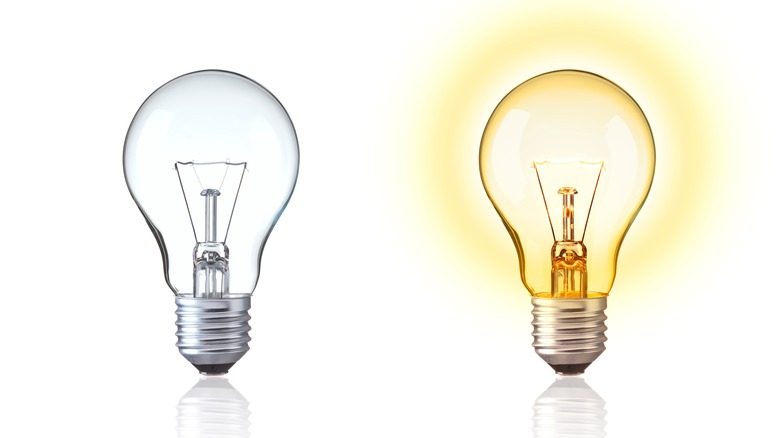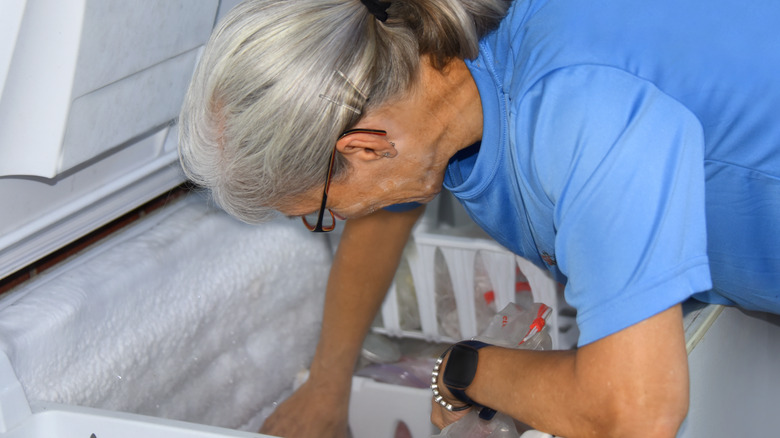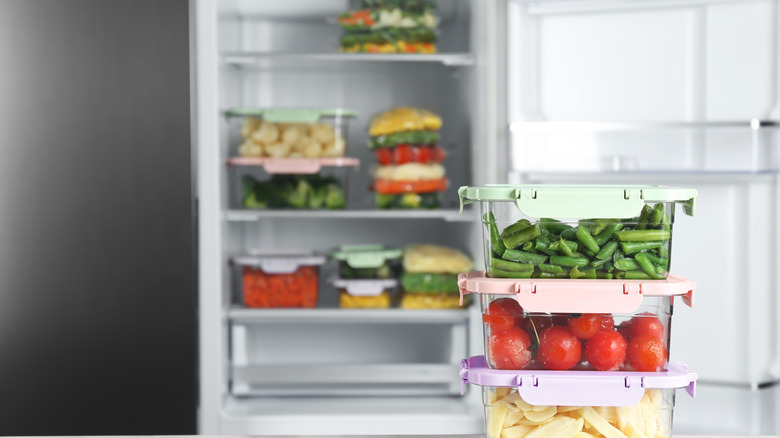Mistakes Everyone Makes When Buying A Chest Freezer
There are many benefits associated with choosing a chest freezer. As Spencers TV & Appliance explains, chest freezers are more energy efficient than upright models. With their airtight locking seal along the lid, these models require less energy to keep foods cold than upright freezers, which have can have gaps along the door frame. And, because of this airtight seal and a chest freezer's ability to maintain a consistently cold temperature, foods can stay fresher longer compared to upright freezers.
Chest freezers also tend to operate more quietly than upright freezers. They will keep foods frozen and safe for longer than upright freezers during a power outage. Thanks to their thicker insulation, cooler air stays around frozen foods, allowing them to stay frozen for up to 72 hours, a full 24 hours longer than upright freezers are capable of.
However, despite all of these many benefits associated with chest freezers, you won't want to just rush off to the store to buy one. First, take a few minutes to read about some common mistakes that shoppers make when buying a chest freezer so you'll be able to avoid them.
Purchasing a model that is too large for the available space
Before shopping for a new chest freezer, you'll need to determine where in your home you plan to place it. First, decide on the ideal location for the freezer. Then, measure the available space to help you choose a freezer that won't be too large for the area.
As Whirlpool points out, the dimensions of a chest freezer will vary based on whether you choose a compact, small, medium, or large model. Compact chest freezers are the smallest options between 21 and 28 inches wide and 19 and 22 inches deep. On the under hand, the largest models tend to be between 72 and 84 inches wide and 27 and 32 inches deep.
In addition to leaving space for the footprint of the freezer, you'll also need to ensure that there is enough room along the sides and back of the freezer. GE Appliances states that chest freezers should have a minimum of three inches of clearance along the sides and three inches of clearance along the back. This means that you will not be able to push your freezer all the way back against a wall or right up against another appliance or bulky item in your home so keep that in mind while measuring your space.
Choosing a chest freezer that doesn't hold enough
One of the main benefits of investing in a chest freezer is the additional space you'll gain to stock up on food for yourself and your family. You don't want to purchase a chest freezer only to discover that it is too small after a few trips to the grocery store. Before you begin shopping for your new freezer, consider your storage needs to make sure that the model you purchase offers a large enough capacity.
When deciding on the ideal chest freezer capacity for your needs, Maytag suggests using the number of people living in your home to guide your decision, allowing at least 2.5 cubic feet of space for each person in the home. Keep in mind that each cubic foot can provide storage for around 25 pounds of food. But it's important to also consider the types of items you plan on storing in your freezer. For example, if you plan to freeze items that take up a lot of space like hams or turkeys, then you might want to get a larger model than the family size formula indicates.
Buying a non-ENERGY STAR model
When shopping for any appliances, including a chest freezer, it is a good idea to look for ENERGY STAR-certified models. As ENERGY STAR explains, the program is designed to help consumers and businesses learn more about the efficiency of appliances so that they can reduce energy costs, while also decreasing their environmental footprint. The ENERGY STAR program has saved households and businesses over $500 billion in energy costs since it was started in 1992.
There are some great benefits to choosing a freezer that is certified through the program. All ENERGY STAR-certified units are a minimum of 10% more energy efficient than the minimum standard set by the federal government. These models are also designed with efficiency in mind. They use top-of-the-line insulation to keep temperatures more constant and more efficient components that utilize less electricity. On average, you can expect an ENERGY STAR-certified chest freezer to account for only $30 in yearly energy costs.
Forgetting about child safety locks
If you have young children at home and are shopping for a new chest freezer, looking for a model with child safety locks is important. If a child decides to climb into a chest freezer, they can become trapped and suffocate to death. Inside Edition shares a tragic story about three young children in Florida who climbed into a chest freezer and then were unable to get out. All three children sadly died in the freezer before they were discovered.
Ron Hazelton, a safety expert, worked with Inside Edition to emphasize the huge safety risk that chest freezers pose for children. These models have very heavy lids, designed to keep foods cold and fresh. However, these heavy lids, are also very difficult, or even impossible, to open from the inside. Chest freezers also have a lot of insulation to keep the cold air in. This insulation can muffle sound and block it from being heard from the outside. So, even if children who get in the freezer call for help, it is unlikely that anyone will be able to hear them. To avoid a tragedy like what happened in Florida, be sure to choose a chest freezer with a lock, and secure the lid at all times. When disposing of an old unit, take off the hinges to remove the lid to prevent any accidents.
Not looking for a model with a temperature alarm
When buying a new chest freezer, you'll also want to look for a model with a temperature alarm. These alarms will go off if the internal temperature gets too warm and threatens the safety of the food in the freezer. A temperature alarm can be the difference between a thawed freezer full of wasted food or averting a crisis before it is too late.
As the USDA reports, meats that are thawed in temperatures under 40 degrees Fahrenheit should be eaten quickly to avoid potential health concerns. Poultry, ground meat, and fish should be cooked within one or two days, while pork, beef, veal, and lamb should be cooked within three to five days. Without a temperature alarm, your meats could thaw fully and become unsafe to cook. Even with the best-case scenario, if you catch this while the temperature is still low enough for them to be considered safe to eat, you may end up with more thawed meat to cook than you'll be able to eat, resulting in a ton of food waste.
Forgetting about interior lighting
Not all chest freezers offer interior lighting. While this isn't a feature that will impact the freezer's performance, it can definitely have a negative impact on convenience and organization. SMAD Group shares that this is a feature that many consumers don't think about when they're shopping for a new freezer. Most stores have bright overhead lights, which can make a freezer's interior plenty bright. Only once they get the freezer home to a space that doesn't offer such bright lighting do customers realize their mistake.
Make sure to confirm that the freezer you're looking for offers interior lighting before making a purchase. Having an interior light will help with keeping the chest freezer organized, especially if it's located in a dark garage or dim basement. Similarly, with an interior light, you'll be able to quickly find the food item you're looking for, rather than trying to juggle a flashlight as you look around. As an added benefit, shorter search times mean that the freezer's lid won't be open for very long helping to retain the temperature and conserve energy.
Not purchasing a garage-ready model
While the garage often seems like a logical space for an extra freezer with its more spacious layout, Consumer Reports cautions readers about putting just any freezer in their garage. Garages can be subject to drastic temperature ranges. However, putting a freezer in the garage isn't always so problematic if you live in a more temperate climate that doesn't deal with hot or cold temperature extremes. Likewise, if you have a climate-controlled garage, you also won't need to worry about keeping a freezer in it.
But in periods of extreme heat, the garage's temperature can get too hot. The freezer then has to work extra hard to keep food cold, causing your energy bills to increase. On the other hand, in a severely cold garage, you may think that below-freezing temperatures would help keep your foods frozen, but that isn't always the case. If the temperature in the garage gets too cold, the freezer's compressor may shut off, thinking that the correct freezer temperature is being maintained. However, if this happens, it can cause the food inside the freezer to thaw or be stored at inconsistent temperatures.
Fortunately, there is a solution. If you're planning to put a freezer in the garage, you'll want to choose a garage-ready model. Robust Kitchen explains that garage-ready freezers are specifically designed to maintain optimal interior temperatures, even when exposed to hot or cold external temperatures. These models are typically rated for use in garages and other locations that range between 0 degrees Fahrenheit and 110 degrees Fahrenheit. To achieve these higher levels of performance, there are some additional features found in garage-ready freezers. These include thicker insulation, a stronger seal, a more powerful compressor, and multiple thermostats to monitor the interior temperature.
Not considering an upright freezer
Before finalizing your decision to purchase a chest freezer, make sure it's actually a better fit for your needs than an upright model. As Aztec Appliance points out, each type of freezer comes with its own set of pros and cons. Weighing these against your unique circumstances can help you make the best decision.
While an upright freezer typically costs a bit more to purchase than a chest freezer, they offer a more organized layout. Featuring shelves, rather than a large compartment and a few baskets, it is easier to keep foods in an upright freezer visible and accessible. The layout of an upright freezer also makes it easier to clean than its chest freezer counterparts. You can also find upright freezers with an auto-defrost feature, which makes defrosting the freezer easier and less messy. However, upright freezers use more energy than chest freezers, which means that they will cost more to operate. Foods will also thaw more quickly in an upright freezer if the power goes out. An upright freezer is also less likely to last as long, featuring a 10 to 15-year lifespan compared to the 15 to 20-year average life of a chest freezer.
There are some key benefits of choosing a chest freezer. These include increased storage space and better energy efficiency. Some of the downsides of chest freezers include their larger footprint and the lack of a feature that automatically defrosts your chest freezer. Also, most chest freezers don't have as convenient of a layout as an upright feature, which can make it more difficult to clean the interior and keep foods organized.
Spending too much money
As you shop for a chest freezer, be sure to also keep your budget in mind. According to HomeServe, the cost to purchase a new chest freezer can run between $300 and $1,000 depending on the size and different features you're looking for. If necessary, you may need to make some compromises to make sure you stay within your budget.
When you're shopping for a new chest freezer, you may also be able to find additional ways to save money. East Coast Appliance shares tips to help consumers find the best deal on a new appliance. First, look at the calendar before you shop and think about when appliance retailers are most likely to be offering bigger discounts and sales. There are a few holidays when you're likely to find the best prices for new appliances, including Memorial Day, Independence Day, Labor Day, Veterans Day, and Black Friday.
Another tip to save money is to consider buying a scratched or dented chest freezer. Models with these cosmetic defects are often discounted by about 15%. Some retailers offer an outlet or discount section where you'll be able to view these imperfect models. Chances are that your chest freezer isn't going into a very prominent location in your home, anyway, so why not save a bit of money by looking for a blemished model?
